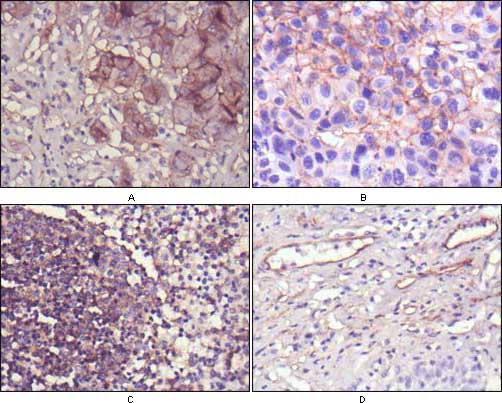
| WB | 1/500-1/1000 | Human,Mouse,Rat |
| IF | 咨询技术 | Human,Mouse,Rat |
| IHC | 1/50-1/100 | Human,Mouse,Rat |
| ICC | 技术咨询 | Human,Mouse,Rat |
| FCM | 咨询技术 | Human,Mouse,Rat |
| Elisa | 咨询技术 | Human,Mouse,Rat |
| Aliases | eN; NT5; CD73 |
| Entrez GeneID | 4907 |
| clone | 1D7 |
| WB Predicted band size | 70kDa |
| Host/Isotype | Mouse IgG1 |
| Antibody Type | Primary antibody |
| Storage | Store at 4°C short term. Aliquot and store at -20°C long term. Avoid freeze/thaw cycles. |
| Species Reactivity | Human |
| Immunogen | Purified recombinant fragment of NT5E expressed in E. Coli. |
| Formulation | Purified antibody in PBS with 0.05% sodium azide. |
+ +
以下是关于Junctional Adhesion Molecule 1(JAM-1)抗体的3篇参考文献及其简要摘要:
1. **"Junctional adhesion molecule-1 (JAM-1) regulates endothelial barrier function through interactions with the PDZ domain protein ZO-1"**
- **作者**: Martin-Padura, I. et al.
- **摘要**: 该研究利用JAM-1抗体阻断内皮细胞间连接,发现JAM-1通过与ZO-1蛋白的相互作用调控内皮屏障完整性,提示其在血管通透性和炎症反应中的作用。
2. **"JAM-1 regulates cell migration through a Shp2–Rap1 signaling axis"**
- **作者**: Weber, C. et al.
- **摘要**: 研究使用中和性JAM-1抗体,证明JAM-1通过激活Shp2-Rap1信号通路调控单核细胞迁移,为炎症和动脉粥样硬化中JAM-1的功能提供机制解释。
3. **"Targeting JAM-1 inhibits SARS-CoV-2 lung cell infection via disruption of ACE2-mediated viral entry"**
- **作者**: Bazzoni, G. et al.
- **摘要**: 通过JAM-1抗体阻断实验,发现JAM-1与ACE2受体相互作用,抑制SARS-CoV-2进入肺上皮细胞,为抗病毒治疗提供潜在靶点。
4. **"Junctional adhesion molecule-A contributes to tumor angiogenesis and metastasis"**
- **作者**: Naik, M.U. et al.
- **摘要**: 使用JAM-1特异性抗体阻断肿瘤微环境中的JAM-1功能,发现其抑制血管生成和肿瘤转移,表明JAM-1在癌症进展中的关键作用。
以上研究展示了JAM-1抗体在细胞屏障、炎症、病毒感染及癌症研究中的多功能应用。
Junctional Adhesion Molecule 1 (JAM-1), also known as JAM-A or F11R, is a transmembrane glycoprotein belonging to the immunoglobulin superfamily. It plays a critical role in maintaining cell-cell contacts at tight junctions, particularly in endothelial and epithelial cells. JAM-1 facilitates leukocyte transmigration during inflammation by interacting with ligands like LFA-1 on immune cells. It also contributes to platelet activation, angiogenesis, and barrier function regulation.
Antibodies targeting JAM-1 are essential tools for studying its localization, expression, and functional interactions. Polyclonal and monoclonal anti-JAM-1 antibodies are widely used in techniques such as immunohistochemistry, flow cytometry, and Western blotting to explore its involvement in physiological and pathological processes. For instance, JAM-1 antibodies have been employed to investigate its role in inflammatory diseases (e.g., atherosclerosis, inflammatory bowel disease), cancer metastasis (via modulation of epithelial-mesenchymal transition), and viral entry mechanisms (e.g., reovirus binding).
Recent research highlights JAM-1's dual role as both a structural component of junctions and a signaling molecule, influencing cell polarity and proliferation. Antibodies blocking JAM-1 interactions have shown therapeutic potential in preclinical models of autoimmune disorders and ischemia-reperfusion injury. However, context-dependent effects necessitate careful validation of antibody specificity to avoid off-target outcomes. Overall, JAM-1 antibodies remain pivotal in elucidating the molecular dynamics of cellular adhesion and its implications in disease pathogenesis.
×